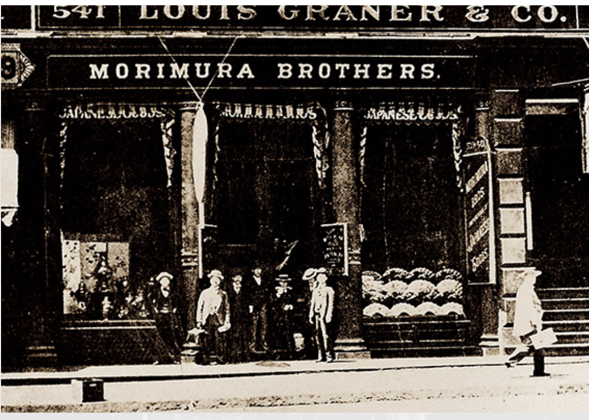
The Story of the Birth of Old Noritake" The Role Played by Morimura family
The birth of Old Noritake was closely tied to the involvement of the Morimura Group. The 250-year rule of the Edo Shogunate began to shift towards opening Japan to the world following the arrival of Commodore Perry's Black Ships in 1853. This led to the signing of the Treaty of Amity and Commerce between Japan and the United States on July 29, 1858 (Ansei 5), aboard the American ship USS Powhatan anchored off the coast of Koshiba, Edo Bay. The treaty was signed between the Shogunate representative, Inoue Shinano no Kami Kiyonao, and U.S. Consul General Townsend Harris.
To exchange the ratified treaty documents, the Shogunate decided to send Niimi Buzen no kami Masayoshi as a special envoy to Washington, D.C. During this time, a merchant named Morimura Ichizaemon (1839-1919), who was well-versed in Yokohama trade and frequently dealt with daimyo estates, played a crucial role. He was responsible for procuring gifts for the U.S. President and handling the currency exchange needed for Niimi's journey.
Morimura successfully transported 30,000 ryo (equivalent to 30 chests of gold coins and silver pieces) with the help of 30 laborers and 10 samurai guards to Yokohama, where he exchanged them for the Mexican silver currency used at the time.

Morimura Ichizaemon (1839-1919)
At that time, Morimura Ichizaemon compared the sooty Mexican silver coins he received in exchange with Japan's beautiful gold and silver coins, and felt deeply unsettled. He was also greatly suspicious of the fact that the amount of money he received through the exchange was reduced. Troubled by this, Morimura consulted Kuwana Noboru, the chief retainer of the Okudaira family of Nakatsu Domain, with whom he was close.
Through Kuwana's introduction, Morimura had the opportunity to meet Yukichi Fukuzawa, a fellow samurai from Nakatsu. When Morimura asked Fukuzawa about the outflow of Japanese gold due to currency exchanges with America, Fukuzawa replied, "The trade treaties imposed on us under the threat of cannons are indeed very unfair, but given Japan's current national power, revising the treaties is unrealistic. To strengthen Japan, we must promote foreign trade and earn foreign currency." This advice became a turning point for Morimura, leading him to embark on international business ventures.

Morimura Toyo(1854‐1899年)
In 1876 (Meiji 9), Morimura Ichizaemon founded the Morimura Group, a company aimed at engaging in international trade. He had long recognized the importance of earning foreign currency through 'direct export' carried out by the Japanese themselves, rather than relying on foreign merchants or trading houses. This awareness was cultivated through his business experience in the Yokohama foreign settlement and his interactions with Yukichi Fukuzawa. The same year, he sent his younger brother, Morimura Toyo(1854‐1899年), to the United States. In 1878 (Meiji 11), Toyo rented a store on Front Street in New York and established Morimura Brothers. At that time, Japanese antiques, bronze wares, fans, lanterns, dolls, and ceramics were highly popular due to the influence of Japonism and their novelty, but this interest gradually waned.
In 1883 (Meiji 16), Ichizaemon and Toyo traveled to Europe for market research, attending the Exposition Universelle held in Paris. This experience prompted Morimura Brothers to specialize in the sale of ceramics. European ceramics, particularly those from Meissen, had a history of over 100 years of successful porcelain production and were highly regarded for their superior designs. Initially, they began by imitating these European designs, and this effort eventually led to the creation of what would later be known as "Old Noritake"—the first Japanese ceramics to adopt Western designs.
Crafted with Japan's finest techniques and artistic sensibilities, Old Noritake became highly popular as an artistic product that fused traditional craftsmanship with exceptional design. Even today, it continues to be cherished by collectors around the world.

Old Noritake EB-906 Vase
Regular price¥800,000 JPY
Vase with pretzel-shaped handles
Rose design
polychrome and gold relief
Production period: circa 1891, Middle Meiji Period
Motifs: Flower, rose
Back stamps: Maple leaf
